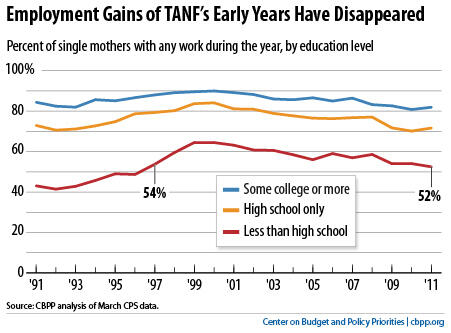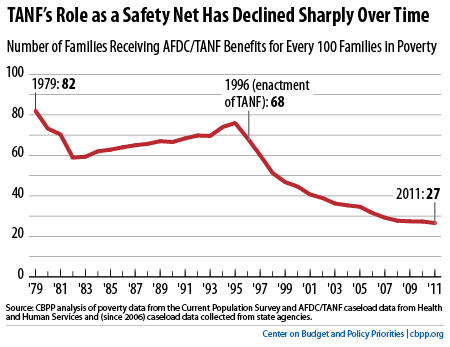off the charts
POLICY INSIGHT
BEYOND THE NUMBERS
BEYOND THE NUMBERS
As House leaders consider next steps on the farm bill (which the House rejected last week), a key question is the fate of its punitive Southerland amendment, which would reward states that end SNAP benefits for unemployed families that want to work.
House Majority Leader Eric Cantor (R-VA) defended the amendment on the House floor by linking it to the 1996 welfare reform law, which created Temporary Assistance for Needy Families (TANF). But, in reality, the amendment is not the same as the work requirements in programs like TANF, and the facts don’t support Rep. Cantor’s claim that the welfare law’s “results were nothing but a success”:
- Fact #1: Single mothers’ employment rose during the early years of welfare reform, but it started losing ground in 2000 and, now, nearly all of those gains have been lost. The share of poorly educated single mothers with earnings rose from 49 percent in 1995 to 64 percent in 2000 but has since fallen or remained constant every year. By 2011, it had fallen to 52 percent — lower than in 1997, which was the first full year of welfare reform implementation (see first graph).
- Fact #2: Welfare reform contributed only modestly to the rise in employment for single mothers during the 1990s. A highly regarded study by University of Chicago economist Jeffrey Grogger found that welfare reform accounted for just 13 percent of the total rise in employment among single mothers in the 1990s. The Earned Income Tax Credit (which policymakers expanded in 1990 and 1993) and the strong economy were much bigger factors, accounting for 34 percent and 21 percent of the increase, respectively.
- Fact #3: TANF, the centerpiece of welfare reform, helps many fewer poor families than its predecessor, Aid to Families with Dependent Children (AFDC). Welfare reform’s modest contribution to raising employment among single mothers came at a very high price. TANF serves only 27 for every 100 families in poverty, down from 68 for every 100 families in poverty before welfare reform, as our report shows (see second graph). Many children face bleaker futures as a result: in 2005, TANF lifted just 650,000 children out of “deep poverty” (that is, raised their family incomes above half the poverty line); ten years earlier, AFDC lifted 2.2 million children out of deep poverty.
- Fact #4: States did not respond to higher need during hard economic times. The Great Recession provided the ultimate test of whether states could do a better job than the federal government of providing a safety net for poor families, as welfare reform’s proponents suggested they could. They failed. While the number of unemployed Americans doubled during the early years of the downturn, the number of TANF recipients rose by just 13 percent and caseloads in 22 states rose little or not at all. When the need for cash assistance rose during the recession, states responded by scaling back their TANF programs to save money — shortening and otherwise tightening time limits and further cutting already low benefit levels, leaving the poorest families poorer. As a result, TANF is emerging from the downturn as an even weaker safety net.
Image

Image

Topics:
Stay up to date
Receive the latest news and reports from the Center
